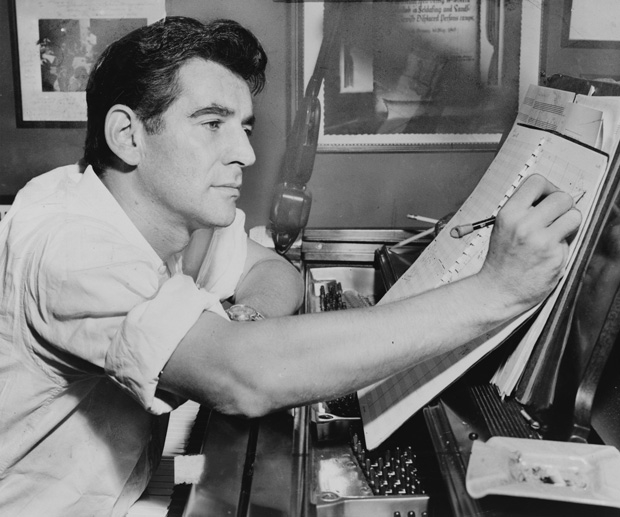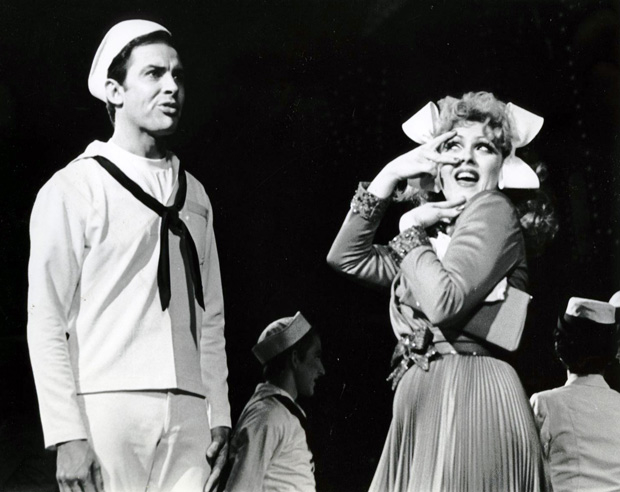The 6 Broadway Musicals of Leonard Bernstein
From West Side Story to Candide, Bernstein’s scores mixed verve with sophistication.

(Al Ravenna, 1955, Wikimedia Commons)
Born 100 years ago, Leonard Bernstein lives on through his music. A conductor, pianist, and educator, he was also a distinctly American composer. His melting-pot works combined jazz, blues, Broadway, rock, gospel, folk, orchestral, and liturgical music. Their forms were as eclectic as their styles: symphonies, choral pieces, ballets, operas, an original film score (On the Waterfront), and most memorably, musicals.
His contributions to musical theater are reflected in this year’s centennial tributes across the United States. The New York Philharmonic, where he served as music director from 1958 to 1969, rang in 2018 with a New Year’s Eve Bernstein on Broadway program, part of a season-long Bernstein festival. The Boston Pops’s celebration of the composer, who made his professional conducting debut with the orchestra at the age of 22, includes a semistaged production of On the Town on May 31 and June 1 as well as a concert performance of West Side Story on June 15 and 16. Preceding them is an April 18 concert production of Candide at Carnegie Hall, featuring John Lithgow as Voltaire and Dr. Pangloss. Theatergoers eager for full productions have the Olney Theatre Center’s On the Town in June and Barrington Stage Company’s West Side Story in August to look forward to.
Bernstein wrote a total of six musicals, each of which made it to Broadway. (So did his one-act opera Trouble in Tahiti, which appeared alongside a Tennessee Williams play and dances by Paul Draper in All in One.) Not all were hits, but even flops like 1600 Pennsylvania Avenue have scores that are admired today for blending hummable melodies, invigorating rhythms, and symphonic complexity. In its own tribute to Bernstein, TheaterMania has put together this overview of his Broadway work. It’s a hell of an oeuvre.
1. On the Town (1944)

(Zodiac Photographers-Abeles/Friedman, Wikimedia Commons)
On the Town sprang from a ballet, Fancy Free, which Bernstein collaborated on with choreographer Jerome Robbins. Betty Comden and Adolph Green provided the book and lyrics for the musical (and costarred in the original Broadway production). The basic story was the same in both mediums: Three sailors on shore leave in New York City seek female companionship. In the musical, they find it in three one-of-a-kind women: aggressive cabbie Brunhilde Esterhazy, a repressed anthropologist named Claire DeLoone, and a Coney Island belly dancer, Ivy Smith, who’s been named this month’s “Miss Turnstiles.” Five years after its Broadway premiere, On the Town was made into an MGM movie starring Gene Kelly and Frank Sinatra. Disappointingly, the studio replaced much of Bernstein’s score, fearing it “too classical” and “too difficult” for audiences.
2. Peter Pan (1950)
This adaptation of J.M. Barrie’s Peter Pan was a “play with songs” that predated the Mary Martin-led musical televised by NBC. Bernstein was asked to compose incidental music and dances for the show, but “losing his head” in the excitement of the project, he wrote seven additional songs. Only five made it into Broadway production, which starred Jean Arthur as Peter Pan, and Boris Karloff as George Darling and Captain Hook. One of the casualties was Wendy’s final number, the sonorous “Dream With Me,” which has gone on to have a second life as a concert standard.
3. Wonderful Town (1953)
Not to be confused with On the Town, Wonderful Town is another musical set in New York City with music by Bernstein and lyrics by Comden and Green. The book writers were Joseph A. Fields and Jerome Chodorov, who based the story on their 1940 play My Sister Eileen. Wonderful Town follows two sisters (originally played on Broadway by Rosalind Russell and Edith Adams) who move to New York City from Ohio and immediately question their decision. Beset by intrusive streetlights and rowdy passersby as they try to sleep in a Greenwich Village apartment, they keen, “Why did I wander to find what lies yonder / When life was so cozy at home?” This standout number distills the doubts of many NYC transplants, not just those from “Ohio.”
4. Candide (1956)
Bernstein composed the music to this “comic operetta,” and an array of writers contributed to the book and lyrics. The first librettist was Lillian Hellman, who came up with the idea of musicalizing Voltaire’s satire. The second was Hugh Wheeler, who wrote a new book for the 1974 revival and won a Tony Award for his efforts. Lyrics came from John La Touche, Richard Wilbur, Dorothy Parker, Stephen Sondheim, and Bernstein himself. All the textual rejiggering is a testament to the music’s robustness. Bernstein’s score sails from the rousing “Best of All Possible Worlds” to the bipolar aria “Glitter and Be Gay” (sung on Broadway by Barbara Cook), from the saucy tango “I Am Easily Assimilated” to “Make Our Garden Grow,” the show’s musical-philosophical conclusion. Listening to the overture is a good way to sample Candide‘s versatility. Here’s a performance of it by the London Symphony Orchestra, with Bernstein himself conducting.
5. West Side Story (1957)
West Side Story has become almost as well known as its source material, Romeo and Juliet. Yet when this adaptation of Shakespeare’s tragedy set in the “west side” neighborhood of 1950s Manhattan premiered on Broadway, it “was disliked by most people,” according to lyricist Stephen Sondheim. West Side Story received just two Tonys, one for choreography and the other for scenic design. (The big winner of the 1957-58 season was The Music Man.) The success that many people now associate with the musical materialized after its movie treatment in 1961. The film, in which Natalie Wood and Richard Beymer starred, went on to win 10 Oscars. Another overlooked piece of West Side Story history is Bernstein’s involvement with the lyrics. As with Candide, he wrote some of them, but he had his credit as lyricist removed from the program during the show’s Washington, DC, tryouts. Reviewers were acknowledging only him, not Sondheim, and Bernstein wanted his songwriting partner to get his due. This performance of “Cool” from a 1958 episode of The Ed Sullivan Show showcases the talent of them both and highlights Jerome Robbins’s choreography.
6. 1600 Pennsylvannia Avenue (1976)
The road to bad theater is paved with good intentions. So it was with 1600 Pennsylvania Avenue, a collaboration between Bernstein and lyricist and book writer Alan Jay Lerner. The two of them wanted to create a musical about the American presidency that recognized the early roles of black people in the White House. Their project took the form of an upstairs-downstairs drama about the presidents and their wives (all of whom were played by Ken Howard and Patricia Routledge) from 1800 to 1900 and about a black family (played by Gilbert Price, Emily Yancy, and Guy Costley) enslaved and later employed there over the same years. Several songs were cut during the show’s out-of-town tryouts, and the end result, suffering from a didactic book, found little favor with audiences. Americans didn’t want to be lectured about racial injustice in the country’s bicentennial year, especially by two white men. The show closed after seven performances on Broadway, and Bernstein and Lerner were so chagrined that they forbade a cast recording. The Bernstein estate continues to honor their wish, though it OK’d an abridged concert version of the musical, titled A White House Cantata, in 1997.









